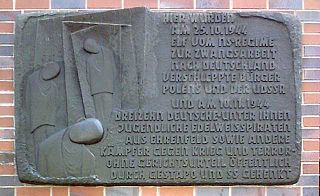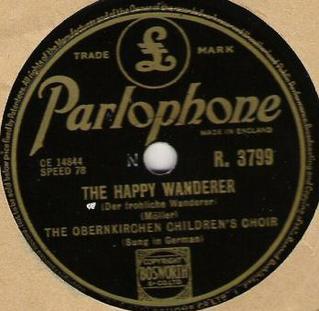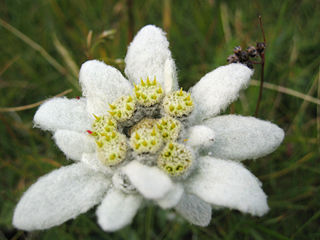Related Research Articles

The Edelweiss Pirates were a loosely organized group of youths opposed to the status quo of Nazi Germany. They emerged in western Germany out of the German Youth Movement of the late 1930s in response to the strict regimentation of the Hitler Youth. Similar in many ways to the Leipzig Meuten, they consisted of young people, mainly between the ages of 14 and 17, who had evaded the Hitler Youth by leaving school and were also young enough to avoid military conscription, which was only compulsory from the age of 17 onward. The roots and background of the Edelweiss Pirates movement were detailed in the 2004 film Edelweiss Pirates, directed by Niko von Glasow.

Leontopodium nivale, commonly called edelweiss, is a mountain flower belonging to the daisy or sunflower family Asteraceae. The plant prefers rocky limestone places at about 1,800–3,400 metres (5,900–11,200 ft) altitude. It is non-toxic and has been used in traditional medicine as a remedy against abdominal and respiratory diseases. Its leaves and flowers are covered with dense hairs, which appear to protect the plant from cold, aridity, and ultraviolet radiation. It is a scarce, short-lived flower found in remote mountain areas and has been used as a symbol for alpinism, for rugged beauty and purity associated with the Alps and Carpathians. It is a national symbol of several countries, specifically Bulgaria, Austria, Slovenia, Switzerland, and Italy. In Romania it was declared a "monument of nature" in 1931. The Edelweiss day is celebrated on 5 March. According to folk tradition, giving this flower to a loved one is a promise of dedication.
Nazi songs are songs and marches created by the Nazi Party. In modern Germany, the public singing or performing of songs exclusively associated with the Nazi Party is now illegal.

The 1st Parachute Division was an elite German military parachute-landing division that fought during World War II. A division of paratroopers was termed a Fallschirmjäger Division. For reasons of secrecy, it was originally raised as the 7th Air Division or (German: 7. Flieger-Division), before being renamed and reorganized as the 1st Parachute Division in 1943.

Kurt Arthur Benno Student was a German general in the Luftwaffe during World War II. An early pioneer of airborne forces, Student was in overall command of developing a paratrooper force to be known as the Fallschirmjäger, and as the most senior member of the Fallschirmjäger, commanded it throughout the war. Student led the first major airborne attack in history, the Battle for The Hague, in May 1940. He also commanded the Fallschirmjäger in its last major airborne operation, the invasion of Crete in May 1941. The operation was a success despite German losses, and led the Allies to hasten the training and development of their own airborne units.
Edelweiss were an Austrian electronic dance music group consisting of remixers Martin Gletschermayer, Matthias Schweger and Walter Werzowa. The group is best known for their 1988 worldwide hit "Bring Me Edelweiss", and their European hit "Starship Edelweiss".

"The Happy Wanderer" is a popular song. The original text was written by Florenz Friedrich Sigismund (1791–1877).

Austrian folk dancing is mostly associated with Schuhplattler, Ländler, polka and waltz. However, there are other dances such as Zwiefacher, Kontratänze and Sprachinseltänze.

"Edelweiss" is a show tune from the 1959 Rodgers and Hammerstein musical The Sound of Music. It is named after the edelweiss, a white flower found high in the Alps. The song was created for the 1959 Broadway production of The Sound of Music, as a song for the character Captain Georg von Trapp. In the musical, Captain von Trapp and his family sing this song during the concert near the end of Act II. It is a statement of Austrian patriotism in the face of the pressure put upon him to join the navy of Nazi Germany following the Anschluss. It is also Captain von Trapp's subliminal goodbye to his beloved homeland, using the flower as a symbol of his loyalty to Austria. In the 1965 film adaptation, the song is also sung by the Captain earlier in the film when he rediscovers music with his children.
In music, a reprise is the repetition or reiteration of the opening material later in a composition as occurs in the recapitulation of sonata form, though—originally in the 18th century—was simply any repeated section, such as is indicated by beginning and ending repeat signs.
Edelweiss Air AG is a Swiss leisure and charter airline and the sister company of Swiss International Air Lines and a subsidiary of the Lufthansa Group. It operates flights to European and intercontinental destinations from its base at Zürich Airport.

"Last Night a D.J. Saved My Life" is a song written by Michael Cleveland, sung by American group Indeep, and released as a single in 1982 by Sound of New York and Becket Records. It features vocals from Réjane "Reggie" Magloire and Rose Marie Ramsey. The track appears as the third track of the namesake album released in 1983.
"Erika" is a German marching song. It is primarily associated with the German Army, especially that of Nazi Germany, although its text has no political content. It was created by Herms Niel and published in 1938, and soon came into usage by the Wehrmacht. It was frequently played during Nazi Party public events. According to British soldier, historian, and author Major General Michael Tillotson, it was the single most popular marching song of any country during the Second World War.
The 7th Parachute Division was a fallschirmjäger (airborne) division of the German military during the Second World War, active from 1944 to 1945.
The II Fallschirmkorps was created in 1943 from Division Meindl, an experienced division on the Eastern Front. In the wake of this new Corps, the 3rd and 5th Fallschirmjägerdivision were raised and attached to the Corps. A year later the Corps was almost completely annihilated while fighting in the Falaise Pocket during the Battle for Normandy. The II Fallschirmkorps was later refitted with replacement troops provided by Fallschirm-Jäger-Ersatz-Battalion 2 and sent to aid the 1st Fallschirm-Armee until their surrender to the Allies in 1945. Under the command of the Werner E. Kranz.

The Fallschirmjäger were the paratrooper branch of the German Luftwaffe before and during World War II. They were the first paratroopers to be committed in large-scale airborne operations. Throughout World War II, the commander of the branch was Kurt Student, as he was the 2nd most senior officer in the luftwaffe.

"Bring Me Edelweiss" is a song by Austrian band Edelweiss, first released in late 1988 as a stand-alone single, then later included on their debut album Wonderful World of Edelweiss. The song was a hit in Europe and New Zealand, reaching the number-one position in six countries and peaking within the top five on several other music charts, going on to sell over five million copies worldwide. The song contains numerous samples from other artists and features yodeling.

Ferdinand Friedrich Hermann Nielebock, known as Herms Niel, was a German composer of military songs and marches.
"One Hand, One Heart" is a song from the musical West Side Story by Leonard Bernstein and Stephen Sondheim. It is a duet sung between Maria and Tony while they have a make-believe wedding, as seen in the stage version and 1961 film, while in the 2021 film, they sing it as they pledge their love to one another inside a church at The Cloisters as part of their date. Larry Kert and Carol Lawrence introduced it in the 1957 Broadway production.

Edelweiss Sausage & Delicatessen, or simply Edelweiss, is a delicatessen in southeast Portland, Oregon's Brooklyn neighborhood, in the United States.